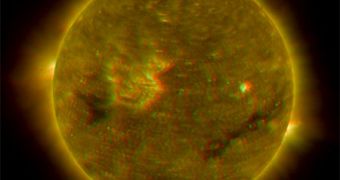The first three-dimensional images of the sun have been released by NASA, enabling scientists, for the first time, to see structures in the sun's atmosphere in three dimensions thus helping them to track solar storms more accurately.
The data transmitted by the twin Solar TErrestrial RElations Observatories, known as STEREO, unveiled some of the first 3-D images of the violent electrical storms that rage within the sun's atmosphere.
"The improvement with STEREO's 3D view is like going from a regular X-ray to a 3D CAT scan in the medical field," said Dr. Michael Kaiser, STEREO Project Scientist at NASA's Goddard Space Flight Center, Greenbelt, US.
The STEREO spacecraft were launched October 25, 2006. On January 21 they completed a series of complex manoeuvres, including flying by the moon, to position the spacecraft in their mission orbits. The two observatories are now orbiting the Sun, one slightly ahead of Earth and one slightly behind, separating from each other by approximately 45 degrees per year.
Researchers say just as the slight offset between a person's eyes provides depth perception, the separation of spacecraft allows 3-D images of the Sun.
"In the solar atmosphere, there are no clues to help us judge distance. Everything appears flat in the 2D plane of the sky. Having a stereo perspective just makes it so much easier," said Dr. Russell Howard of the Naval Research Laboratory, Washington, the Principal Investigator for the SECCHI (Sun Earth Connection Coronal and Heliospheric Investigation) suite of telescopes on the spacecraft.
"With STEREO's 3D imagery, we'll be able to discern where matter and energy flows in the solar atmosphere much more precisely than with the 2D views available before. This will really help us understand the complex physics going on," he said.
Dr. Howard said STEREO's depth perception would also help improve space weather forecasts. Of particular concern is a destructive type of solar eruption called a Coronal Mass Ejection (CME), which are eruptions of electrically charged gas, called plasma, from the Sun's atmosphere.
A CME cloud can contain billions of tons of plasma and move at a million miles per hour. The clouds are laced with magnetic fields. CMEs directed toward Earth smash into our planet's magnetic field and if the CME magnetic fields have the proper orientation, they dump energy and particles into Earth's magnetic field, causing magnetic storms that can overload power line equipment and radiation storms that disrupt satellites.
Though satellite and utility operators can take precautions to minimize CME damage, they need an accurate forecast of when the CME will arrive.
"To do this, forecasters need to know the location of the front of the CME cloud. STEREO will allow scientists to accurately locate the CME cloud front. Knowing where the front of the CME cloud is will improve estimates of the arrival time from within a day or so to just a few hours. STEREO also will help forecasters estimate how severe the resulting magnetic storm will be," said Dr. Howard.
In addition to the STEREO perspective of solar features, for the first time STEREO will allow imaging of the solar disturbances the entire way from the Sun to the Earth. Presently, scientists are only able to model this region in the dark, from only one picture of solar disturbances leaving the Sun and reaching only a fraction of the Sun-Earth distance.

 14 DAY TRIAL //
14 DAY TRIAL //